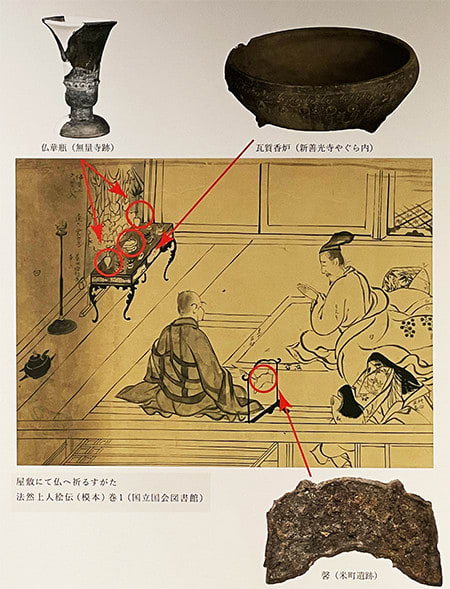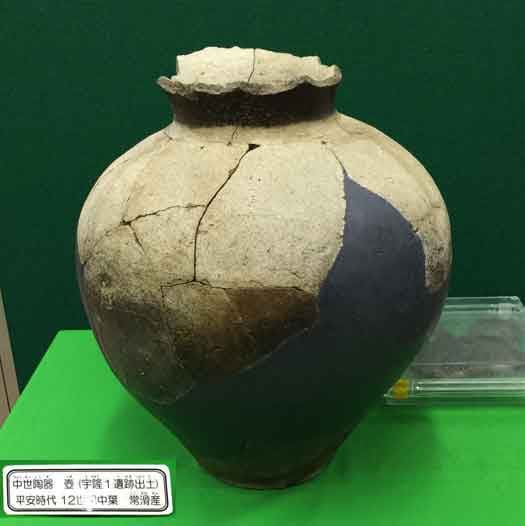



鎌倉歴史文化交流館での展示「中世の祈り」展を参観しての雑感、書き足りなかったことその2です。きのうは鎌倉の永福寺のことだったのですが、この展示を見ていて北海道と奥州藤原氏などとの関係性のことが思い起こされてならなかった。
奥州藤原氏は北海道の厚真町に「経塚」の痕跡が確認されている。経塚というのは中世的仏教のひとつの特徴的痕跡。経塚とは平安末期の「末法思想」への宗教的対応。仏教思想がきちんと人々に伝わっていく時代が終わり「末法の世」世も末という状況がやってくる。まともな思想・仏法が人々の考え方から失せていく。そうした世が56億7,000万年続いた後、ようやく世が救われるとされるのですが、そのとき正しい仏法を伝えるためにいわばタイムカプセルとして、後世に残すモノが経塚。
こういう世界観が人びとに深く信じられ、それが政治にも強い影響を及ぼしていた時代。そういう時代の鎌倉−平泉ー北海道をひと繋がりにする感覚が沸き起こっていたのです。
最初に示した展示パネルは死の床に就いた病者が、布団から身を起こして僧侶の相伴を得て仏具に向かって来世での往生を祈願している様子。かたわらには妻女とみえる女性の涙姿。
2枚目の写真は北海道厚真で発掘された経塚埋蔵物。貴重な「常滑焼」の壷が容器として利用されていた。この時代に愛知県常滑で生産された壷が、波頭を越えてこの地まで運搬され、深い願を込めて埋蔵されていた。3枚目のパネル写真は「板塔婆」の立つ風景。中世的信仰心が殺伐とした世相の中で、来世への希望の象徴として空間構成されたのでしょう。仏教寺院のミニチュア的代替装置。一種の仏教建築ともみなせるものなのだと思います。
この時代の、都から遠く離れた平泉、鎌倉、そして北海道での社会の状況・死生観が深く静かに伝わってくるように思われた。どうしても日本史の中心は畿内地域であり、関東が勃興していってやがて取って代わるほどになるけれど、それ以外の地域の状況はわかりにくい。そういうなかでこのような鄙での「祈り」の文化は、現代人のわれわれにも通底する心象として生々しく理解できる。
北海道島は日本史のなかで「ときどき」登場する(笑)。古代の阿倍比羅夫の遠征事業などが関わりの最初期。そういうなかで奥州藤原氏の時期にはかなり活発な事跡が確認されるようになる。やがてこのことが判官びいきの心情とともに義経の島渡り伝説を生んでいったのだろう。
English version⬇
Hokkaido and Kamakura/Hiraizumi, common traces of medieval Buddhism
On their deathbeds, people pray for a rebirth in paradise in the next life. This wish, which is equal to that of all human beings, is transmitted beyond time and space. The history of the heart that traverses the Japanese archipelago. The history of the heart that traverses the Japanese archipelago.
This is part 2 of my miscellaneous impressions and things I did not write enough about after visiting the "Medieval Prayer" exhibition at the Kamakura Museum of History and Culture. Yesterday it was about Eifukuji Temple in Kamakura, but this exhibition did not remind me of the relationship between Hokkaido and the Oshu Fujiwara clan and others.
The Oshu Fujiwara clan has been confirmed to have traces of "sutra mounds" in Atsuma, Hokkaido. Sutra mounds are one of the characteristic traces of medieval Buddhism. Sutra mounds are a religious response to the "Latter Day Buddhist Thought" of the late Heian period. The era in which Buddhist thought was properly transmitted to the people had come to an end, and a situation called the "Latter Day of the Law" had arrived. The age of "Latter Day of the Law" will come to an end, and decent thought and Buddhism will disappear from the minds of the people. After such a period of 5.67 billion years, it is said that the world will finally be saved, and sutra mounds will be left as a time capsule, so to speak, for future generations to inherit the correct Buddha Dharma.
This worldview was deeply believed by people and had a strong influence on politics. This was a time when people deeply believed in this worldview, and it had a strong influence on politics.
The first panel in the exhibition shows a sick man on his deathbed, rising from his futon, accompanied by a Buddhist priest, praying to a Buddhist altar for his safe passage to the next life. On the other side is a weeping woman who appears to be his wife.
The second photo shows a sutra mound excavated in Atsuma, Hokkaido. A precious "Tokoname ware" jar was used as a container. The third panel photo shows a scene of a "ita-toba" (wooden tablet) standing. It was probably spatially composed as a symbol of hope for the next world in the midst of the bleakness of medieval religious beliefs. A miniature alternative to a Buddhist temple. It can be regarded as a kind of Buddhist architecture.
It seemed to me that the exhibition deeply and quietly conveyed the social conditions and views of life and death in Hiraizumi, Kamakura, and Hokkaido, which were far from the capital during this period. The center of Japanese history is inevitably the Kinai region, and although the Kanto region emerged and eventually took over, it is difficult to understand the situation in other regions. In this context, the culture of "prayer" in such a remote area can be vividly understood as an image that is common to us today.
Hokkaido Island appears "from time to time" in Japanese history (laugh). The first period of involvement was during the Abenohirau expedition in ancient times. In this context, the Oshu Fujiwara Clan was quite active during the period of the Oshu Fujiwara Clan. This, together with the feelings of jealousy toward the magistrate, probably gave birth to the legend of Yoshitsune's island crossing.



















